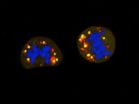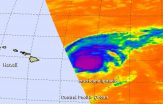(Press-News.org) Cancer cells become addicted to glucose, which they use as their regular source of energy to grow and develop. Although this was observed over nine decades ago by the German physiologist, Otto Warburg; there is still not therapeutic strategy today that can effectively take advantage of this special energy requirement. The initial approach appears to be simple: the lack of glucose could specifically induce the death of cancer cells.
A new study by the Spanish National Cancer Research Centre Cell and Cancer Unit, headed by the Cell Division and Cancer group of the Spanish National Cancer Research Centre, headed Marcos Malumbres, has now proven that blocking glycolysis - the molecular mechanism that makes it possible to extract energy from glucose - is especially damaging to the division of cancer cells and that specifically acting on this energy-based peculiarity could be effective in treating cancer in combination with chemotherapeutic agents such as taxol.
The research project, published in the prestigious journal, Nature Cell Biology, brought together, in addition to a number of CNIO collaborators, the teams headed by Patricia Boya and Eduardo Rial from the Centre for Biological Research (CIB) in Madrid; Raúl Méndez from the IRB Barcelona; Guillermo Velasco, from the Complutense Univeristy of Madrid; Miguel López, from the University of Santiago de Compostela; and Asish Saha, from Boston University.
CHANGES IN CELLULAR METABOLISM
One of the typical aspects of cancer cells is their capacity to divide in an uncontrolled and almost unlimited manner. "There are many therapeutic agents today, such as taxol, that precisely prevent the division of cancer cells by interrupting the mitosis (an especially delicate part of the cell division process in which the genetic material is passed from the mother cell to the daughter cells)", says María Salazar Roa, CNIO researcher and co-director of the study.
One of the issues the researchers are raising is how cancer cells obtain the energy they need to maintain their high rate of division. Using molecular biology and biochemistry techniques, the authors describe, in line with Warburg's theory, how the AMPK and PFKFB3 proteins become significantly active during mitosis, leading cell metabolism towards glycolysis.
"These proteins detect damage to the mitochondria (the cell's energy sources) in response to cell division and make the energy depend mainly on glucose", clarifies Elena Doménech, whose signature appears first on the paper that she has been preparing as her doctoral thesis.
GREATER ADDICTION TO GLUCOSE IN THE PRESENCE OF TAXOL
The researchers also analysed the glucose requirements of cancer cells treated with taxol and, therefore, when mitosis is interrupted. "We can see that antimitotic treatments, such as taxol, increase the need cancer cells have for glucose even more than when there is no treatment", says Salazar.
Based on the fact that cancer cells need more glucose when they are being treated with taxol, the inhibition of glycolysis should enhance the anti-cancer effect of antimitotic drugs. In a way, it would be like forcing them to need more glucose and, at the same time, preventing its use. Then, the cancer cells would die of starvation as they would be unable to obtain the energy they need to cover their vital functions.
CANCER CELL DEATH BY STARVATION
The authors used cellular models taken from breast cancer and mice, finding that, indeed, mitotic drugs, such as taxol, are more efficient when the cells' ability to metabolize glucose is eliminated using PFKFB3 inhibitors.
"The therapeutic value of inhibiting PFKFB3 has often been discussed; however, no appropriate cell-based scenario had been proposed for its clinical use. Our results suggest that PFKFB3 inhibitors can be extremely efficient in combination with antimitotic drugs", explains Malumbres.
Taxol, a compound derived from the bark of the yew tree, is one of the greatest revolutionary elements in the history of chemotherapy over the last 25 years. Today, other taxanes, such as paclitaxel and docetaxel, are part of the standard treatment provided in the case of certain cancers, such as lung, breast and ovarian cancer. Other antimitotic drugs are the alkaloids derived from Vinca (Catharanthus roseus), such as vinblastine, vincristine and vinorelbine, widely used to treat leukaemia, lymphoma and melanoma. The future direction, according to the team from CNIO, will be to identify groups of patients with these and other tumours in which to enhance the effects of antimitotic agents by blocking the tumour's energy source.
INFORMATION:
María Salazar Roa was granted a post-doctoral contract by the Scientific Foundation of the Spanish Association against Cancer (AECC) to undertake these studies aimed at seeking new therapies against cancer. The work of the CNIO has also been funded by the Ministry of Economy and Competition, the Community of Madrid, the international foundation Worldwide Cancer Research and the European Union.
A UCSF-led team has developed a technique to build tiny models of human tissues, called organoids, more precisely than ever before using a process that turns human cells into a biological equivalent of LEGO bricks. These mini-tissues in a dish can be used to study how particular structural features of tissue affect normal growth or go awry in cancer. They could be used for therapeutic drug screening and to help teach researchers how to grow whole human organs.
The new technique -- called DNA Programmed Assembly of Cells (DPAC) and reported in the journal Nature Methods ...
Scientists from the D'Or Institute of Research and Education (IDOR), the Federal University of Rio de Janeiro (UFRJ) and the Yale University School of Medicine have elucidated the chemical process behind a mysterious gastrointestinal disease that is becoming more frequent every day: the eosinophilic esophagitis (EoE), also known as the "asthma of the esophagus". The researchers identified a molecule which plays a key role in this condition and that can be a target in a new therapeutic strategy.
The eosinophilic esophagitis is a chronic inflammatory disorder of the esophagus. ...
While the French High Council for Public Health (HCSP) made public on Monday, 24 August 2015, a positive opinion regarding the relevance of the 5-colour code for the public, a team of researchers (Inserm/INRA/Paris 13 University) directed by Serge Hercberg, on publication of their article in the journal Nutrients, demonstrated that the 5-colour nutrition label (5-CNL) is the most effective nutritional information system for allowing consumers to recognise and compare the nutritional quality of foods, including "at-risk" populations (older subjects, those with a lower educational ...
Amsterdam, NL, August 31, 2015 -- Every week in the U.S. an average of 645 people lose their lives to firearm violence and 1,565 more are treated in an emergency department for a firearm-related injury. Most of these events do not make headlines, but they account for about 7% of the premature deaths before age 65 in the U.S. In a special issue of Preventive Medicine, preventive medicine and health policy experts address a wide range of critical topics related to firearm violence, from the interaction of alcohol abuse with gun violence, effects of changes to gun laws in ...
Alzheimer's disease is associated with the appearance of characteristic neurotoxic protein aggregates in various regions in the brain. Chemical analysis of these insoluble deposits reveals that they are made up of a family of short protein fragments, referred to as beta-amyloid peptides, which are derived from a precursor protein called APP by the sequential action of two enzymes. An international team of researchers led by Christian Haass (Professor of Metabolic Biochemistry at LMU and Speaker for the German Center for Neurodegenerative Diseases in Munich) and Dr. Michael ...
ROCHESTER, Minn. -- About 20 percent of colorectal cancer patients have cancers that have spread (metastasized) beyond the colon at the time of their diagnosis. The liver is the most common site for these metastases. The approach to treating primary tumors within the colon and metastatic tumors in the liver continues to evolve; however, it typically involves chemotherapy plus surgical removal (resection) of both types of tumors. However, experts continue to debate whether surgical resection of primary tumors and metastatic tumors should be performed at the same time (synchronously) ...
LAWRENCE -- Renewable wind energy is experiencing a boom, with more wind turbines popping up across landscapes in the U.S. and abroad. Indeed, wind energy accounted for 3.3 percent of electricity generation in the United States in 2011, according to the U.S. Energy Information Administration. Globally, that number was 2.9 percent for the same year.
But as wind turbines proliferate, researchers at the University of Kansas are looking at how these forests of turbines affect the wind itself. What happens to the wind when a larger number of wind turbines removes more and ...
NASA's Aqua satellite passed over Hurricane Ignacio and viewed the storm in infrared light, providing valuable temperature data. Aqua saw a weaker Ignacio moving parallel to the Hawaiian Islands.
The Atmospheric Infrared Sounder or AIRS instrument aboard Aqua gathers infrared data that shows temperatures. That AIRS data was made into a false-colored infrared image from August 30 at 22:47 UTC (6:47 p.m. EDT) and showed high, cold, strong thunderstorms surrounded the center of Hurricane Ignacio.
AIRS imagery also showed a thick band of thunderstorms spiraling into the ...
Researchers link babies' performance on cognitive tasks to later learning progress
Study underscores importance of talking to your baby well before they can talk back
Findings may eventually contribute to reducing "vocabulary gap"
EVANSTON, Ill. --- At 12 months old, your infant's ability to group objects according to the names associated with them -- as opposed to their appearance alone -- offers a glimpse into how his or her vocabulary will develop by the time they are 18 months, Northwestern University researchers have found.
The research, by Brock Ferguson, ...
This news release is available in Spanish. Marine energy has a great future potential according to the experts, but there is still a long way to go before it can be used on a large scale. Despite the problem of intermittency, wave energy has an advantage over wind energy, for example: it is easier to predict optimum swell than some suitable gusts of wind. That is why knowing how much energy the waves will be bringing within a few hours is as important as having available efficient prototypes to make use of wave power. If this information is known, the energy produced ...

